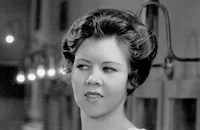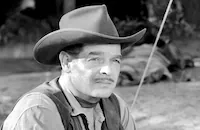Second Honeymoon
Cast & Crew
Walter Lang
Tyrone Power
Loretta Young
Stuart Erwin
Claire Trevor
Marjorie Weaver
Film Details
Technical Specs

Synopsis
Vicky Benton is upset when she runs into her first husband, Raoul McLiesh, at a nightclub in Miami. Although she criticizes him to her second husband Bob as being a waster and joker who gave her no sense of security, seeing him again revives feelings with which she is uneasy. Bob, the manufacturer of Benton Belts, is dependable and has given her a stable life. He takes a liking to Raoul and as a joke sends him a raccoon for company when he is alone. Raoul brings Joy, a talkative cigarette girl from Louisville, to the club, and Bob unsuccessfully propositions her. Seeing that Vicky is upset at Bob and Joy's absence, Raoul covers for him. Raoul organizes a "pragging," or spearfishing, in the Keys and invites Vicky and Bob, along with their friends, Marcia and Herbie. Although Vicky and Raoul greatly enjoy themselves, Bob gets frantic when a giant ray that they have harpooned almost dashes their boat to pieces, and he chops the rope which the ray is pulling. That night, neither Raoul nor Vicky can sleep, and they meet unplanned at the dock. They discuss their marriage fondly, but when Raoul begins to insult Vicky's mother and Bob, Vicky breaks down crying, and Raoul says he'll leave Miami. When Raoul learns that Bob has to go back to New York because of a factory strike, however, he decides to stay and returns the raccoon to Bob. Vicky is upset at Raoul for the practical joke, but soon they spend a lot of pleasurable time together. One night, Vicky says that she is sick of pretending and pleads for Raoul to take her away with him, but after a passionate kiss, Raoul reminds her that they've never done anything cheaply and suggests that they stop because of the mess their lives are in. When Raoul learns that his eccentric valet, Leo MacTavish, and Joy are going to be married the next day, he hires Mac as his personal representative at his ink factory and makes plans for them to charter a plane for him to go to Key West, which the honeymoon couple will then take to Havana. That night, Bob calls Vicky and tells her to take the train to New York in the morning because he has to stay there indefinitely. Annoyed by Bob's order, Vicky reveals that she and Raoul have been mentioned in Walter Winchell's gossip columns, and when Bob berates her, Vicky hangs up on him. The next day, when Vicky learns that Joy is married, she mistakenly thinks that Joy married Raoul. Meanwhile, Bob arrives and gets into a fight with Raoul, which leads to their arrest. Vicky bails out Bob, who punches a photographer and tells her to get out of his life. When Joy and Mac arrive at the jail and get Raoul out, the misunderstanding regarding the marriage is cleared up. Vicky and Raoul try to join Mac and Joy on a water plane, but Joy, upset at the delays in their honeymoon, drags Mac off. Vicky and Raoul plan to marry again and kiss.

Director

Walter Lang
Cast

Tyrone Power

Loretta Young

Stuart Erwin

Claire Trevor

Marjorie Weaver

Lyle Talbot

J. Edward Bromberg
Paul Hurst
Jayne Regan
Hal K. Dawson

Mary Treen
William Wagner
Robert Kellard

Lon Chaney Jr.
Charles Tannen
Arthur Rankin

Robert Lowery
Fred Kelsey
Major George C. Mcbride
Sarah Edwards
Wade Boteler
Stanley Blystone
Joseph King
Herbert Fortier
Harry Burkhart
Arthur Stuart Hull
Thomas Pogue
Henry Roquemore
Alex Novinsky

Phil Smalley
Don Marion
Troy Brown
Philippa Hilbere
Lillian Porter
Crew
Dave Anderson
Don Anderson
Sid Bowen
John Brady
Jerry Braun
Gene Bryant
David Buttolph
Bill Cooley
Fred Dawson
Lucille De Antoine
Ed. Ebele
William Fremdling
Bud Gaunt
Charlie Graham
W. Grefrath
Raymond Griffith
Eugene Grossman
David Hall
Harold Hammack
Roger Heman
Bernard Herzbrun
James Jensen
Jack Lescoulie
W. H. Leverett
Thomas Little
Robert Mack
Cliff Maupin
Carrie O'neil
Pat Palamountain
Ernest Palmer
Helen Parker
George Peckham
C. W. Penner
Allen Rivkin
Kathryn Scola
Ben Silvey
Jean Thomas
Walter Thompson
Lamar Trotti
Don Wakeling
Gwen Wakeling
Darrell Ware
Henry Weinberger
Darryl F. Zanuck

Film Details
Technical Specs

Quotes
Trivia
Notes
According to information in the Twentieth Century-Fox Records of the Legal Department at the UCLA Theater Arts Library, the studio purchased Philip Wylie's story before publication when it was entitled Worship the Sun. According to New York Times, Marjorie Weaver, through her role in this film, won the patronage of Loretta Young, who induced the studio to give her a chance in a leading role in a film. Daily Variety expressed pleasure with Weaver and commented that she "has a fresh, unspoiled charm and vivacity, an ingenuous frankness and attractive personality, which completely captivated the preview audience...." According to a Hollywood Reporter news item, Phyllis Brooks was forced to withdraw from the cast because of illness, and she was replaced by Louise Henry. Henry was subsequently replaced by Claire Trevor in the role of "Marcia."
According to the legal records, this film marked the first time that the I.A.T.S.E. (International Alliance of Theatrical and Stage Employees) legend was used in the credits of a Twentieth Century-Fox film. Correspondence in the records states that the producers' organization had recently agreed to include the legend on all films. The legal records also indicate that producer Larry Darmour applied for an injunction to keep Twentieth Century-Fox from using the title Second Honeymoon. Darmour contended that he owned the rights to a British novel entitled The Second Honeymoon, which his company, Continental Talking Pictures, produced as a film in 1930 (see AFI Catalog of Feature Films, 1921-30; F2.4876) and that the release of a Twentieth Century-Fox film of the same title would interfere with a release of a remake of the novel, if he decided to produce one. After a New York court denied Darmour's application for injunction, Darmour threatened to start a suit in England. Additionally, Darmour wrote a letter of complaint to Will H. Hays, MPPDA President, and threatened to take the matter up with the Department of Justice, claiming that Twentieth Century-Fox ignored his claim to the title because he was an independent producer. No further information concerning Darmour's subsequent actions was found in the legal records. In 1942, Twentieth Century-Fox released another film based on the same source, entitled Springtime in the Rockies, which was directed by Irving Cummings and starred Betty Grable, John Payne, Carmen Miranda and Cesar Romero.












